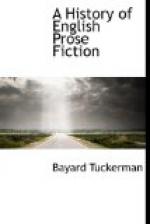The same courage and industry were carried by Mrs. Inchbald into her literary labors, the profits of which enabled her to live with considerable comfort toward the end of her life. She left a large number of plays, many of which had been acted with success, and two novels, “A Simple Story,” published in 1791, and “Nature and Art,” published five years later. Neither of these works has much merit from a critical point of view. They are faulty in construction, and give frequent evidence of the authoress’ lack of education.
Yet, in her ability to excite the interest and to move the feelings of her reader, Mrs. Inchbald met with great success. Her novels are of the pathetic order, and appeal to the sympathies with a sometimes powerful effect. Maria Edgeworth was deeply moved by the “Simple Story.” “Its effect upon my feelings,” she said after reading it for the fourth time, “was as powerful as at the first reading; I never read any novel—I except none,—I never read any novel that affected me so strongly, or that so completely possessed me with the belief in the real existence, of all the persons it represents. I never once recollected the author whilst I was reading it; never said or thought, that’s a fine sentiment,—or, that is well expressed—or, that is well invented; I believed all to be real, and was affected as I should be by the real scenes, if they had passed before my eyes; it is truly and deeply pathetic.”
The sisters, Harriet and Sophia Lee, wrote a number of stories gathered together under the rather unfortunate title of “The Canterbury Tales,” which had a long-continued popularity. “The Young Lady’s Tale,” and “The Clergyman’s Tale” were written by Sophia; all the others, together with the novel “Errors of Innocence,” belonged to Harriet. These stories have great narrative interest, and contain some powerfully drawn characters. Byron was deeply affected by some of them. Of the “German’s Tale,” he confessed: “It made a deep impression on me, and may be said to contain the germ of much that I have since written.” It not only contained the germ of “Werner,” but supplied the whole material for that tragedy. All the characters of the novel are reproduced by Byron except “Ida,” whom he added. The plan of Miss Lee’s work is exactly followed, as the poet admitted, and even the language is frequently adopted without essential change.
Charlotte Smith was a woman of talent and imagination who was driven to literature for aid in supporting a large family abandoned by their spendthrift father. She was among the most prolific novelists of her time, but only one work, “The Old Manor House,” enjoyed more than a passing reputation, or has any claim to particular mention here. The chief merit of Charlotte Smith’s novels lies in their descriptions of scenery, an element only just entering into the work of the novelist.
Clara Reeve and the celebrated Mrs. Radcliffe did much to sustain the prominent position which women were taking in fictitious composition, and their works will be commented upon in connection with the romantic revival, to which movement they were eminent contributors.




